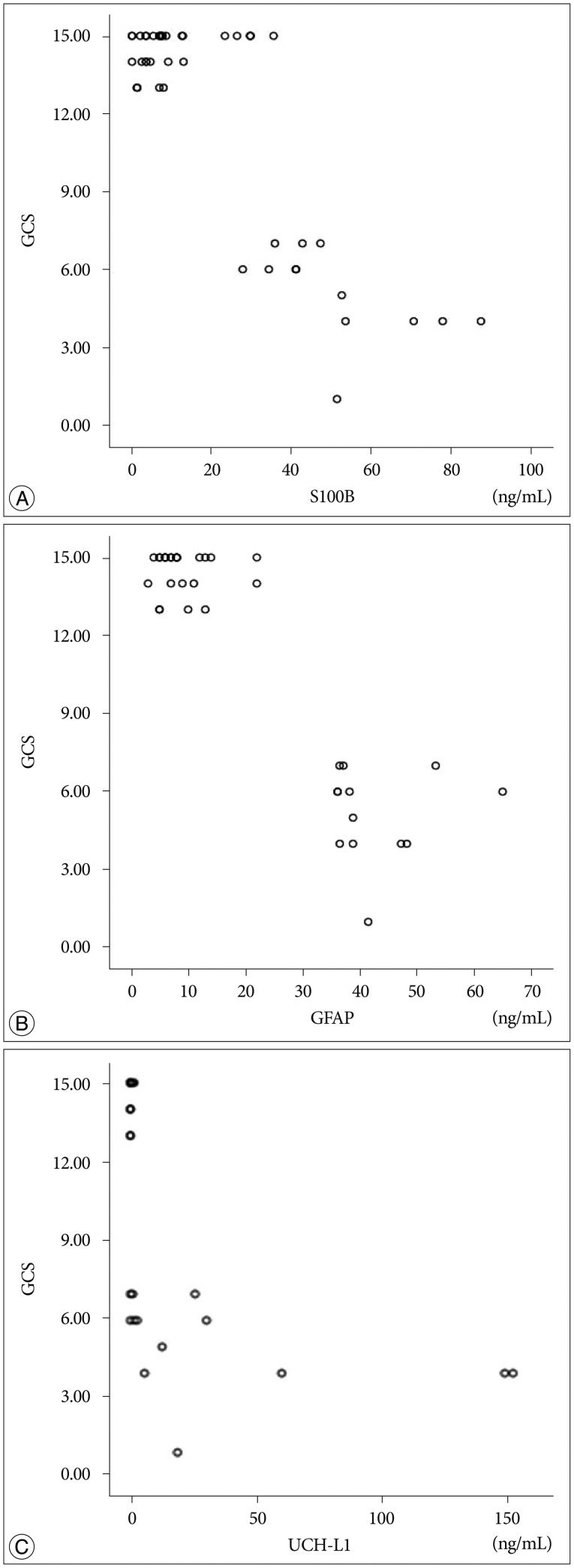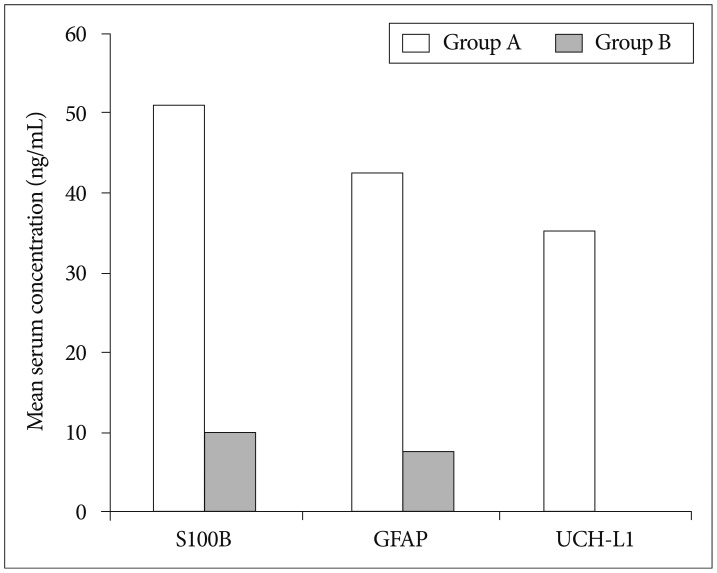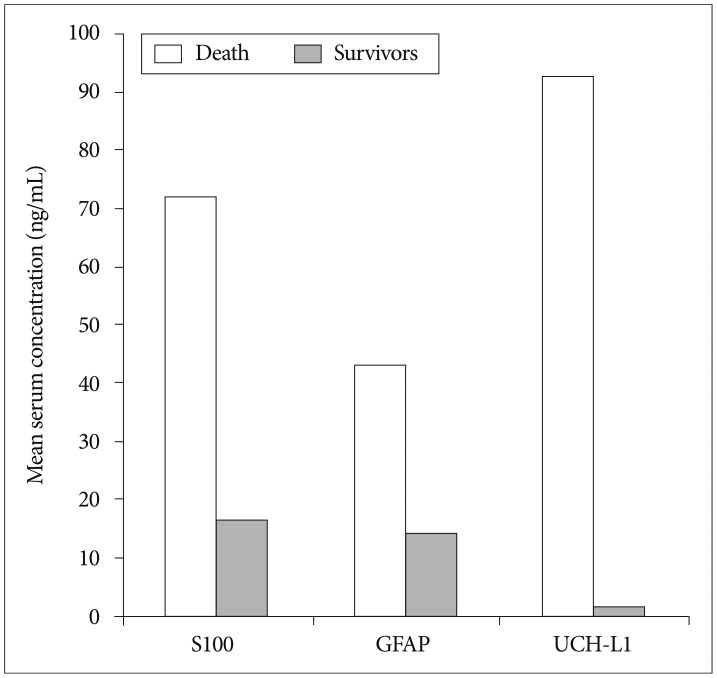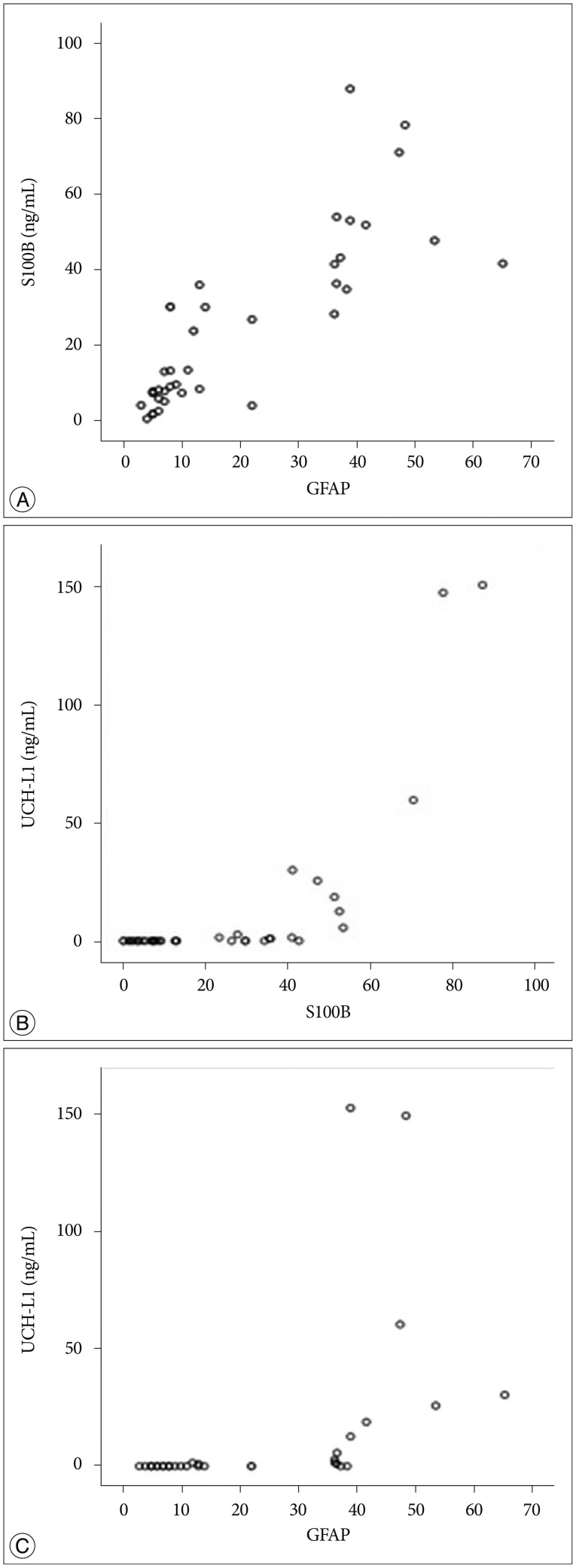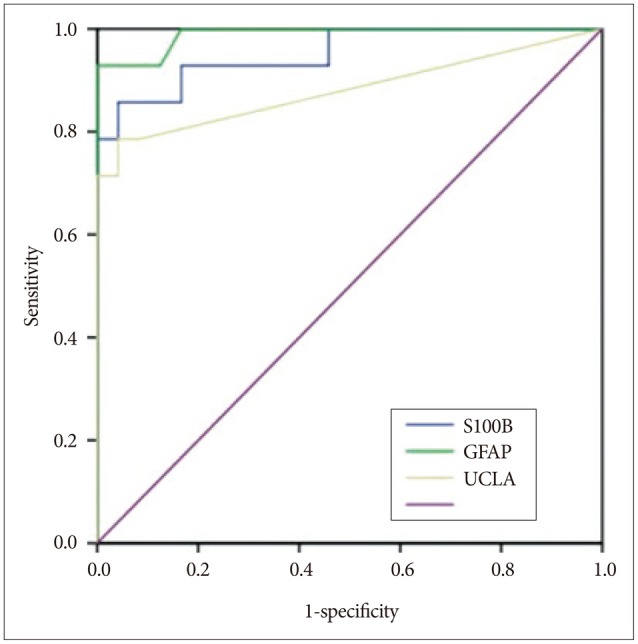J Korean Neurosurg Soc.
2015 Aug;58(2):93-100. 10.3340/jkns.2015.58.2.93.
A Role of Serum-Based Neuronal and Glial Markers as Potential Predictors for Distinguishing Severity and Related Outcomes in Traumatic Brain Injury
- Affiliations
-
- 1Department of Neurosurgery, Konyang University Hospital, Daejeon, Korea. leecy009@hanmail.net
- 2Graduate School of Medicine, Kyung Hee University, Seoul, Korea.
- 3Konyang University Myunggok Medical Research Institute, Daejeon, Korea.
- KMID: 2191315
- DOI: http://doi.org/10.3340/jkns.2015.58.2.93
Abstract
OBJECTIVE
Optimal treatment decision and estimation of the prognosis in traumatic brain injury (TBI) is currently based on demographic and clinical predictors. But sometimes, there are limitations in these factors. In this study, we analyzed three central nervous system biomarkers in TBI patients, will discuss the roles and clinical applications of biomarkers in TBI.
METHODS
From July on 2013 to August on 2014, a total of 45 patients were included. The serum was obtained at the time of hospital admission, and biomarkers were extracted with centrifugal process. It was analyzed for the level of S-100 beta (S100B), glial fibrillary acidic protein (GFAP), and ubiquitin carboxy-terminal hydrolase-L1 (UCH-L1).
RESULTS
This study included 33 males and 12 females with a mean age of 58.5 (19-84) years. TBI patients were classified into two groups. Group A was severe TBI with Glasgow Coma Scale (GCS) score 3-5 and Group B was mild TBI with GCS score 13-15. The median serum concentration of S100B, GFAP, and UCH-L1 in severe TBI were raised 5.1 fold, 5.5 fold, and 439.1 fold compared to mild injury, respectively. The serum levels of these markers correlated significantly with the injury severity and clinical outcome (p<0.001). Increased level of markers was strongly predicted poor outcomes.
CONCLUSION
S100B, GFAP, and UCH-L1 serum level of were significantly increased in TBI according to severity and associated clinical outcomes. Biomarkers have potential utility as diagnostic, prognostic, and therapeutic adjuncts in the setting of TBI.
Keyword
MeSH Terms
Figure
Cited by 1 articles
-
Effects of Quercetin and Mannitol on Erythropoietin Levels in Rats Following Acute Severe Traumatic Brain Injury
Orhan Kalemci, Hasan Emre Aydin, Ceren Kizmazoglu, Ismail Kaya, Hulya Yılmaz, Nuri M Arda
J Korean Neurosurg Soc. 2017;60(3):355-361. doi: 10.3340/jkns.2016.0505.015.
Reference
-
1. Alpert JS, Thygesen K, Antman E, Bassand JP. Myocardial infarction redefined--a consensus document of The Joint European Society of Cardiology/American College of Cardiology Committee for the redefinition of myocardial infarction. J Am Coll Cardiol. 2000; 36:959–969. PMID: 10987628.
Article2. Anderson RE, Hansson LO, Nilsson O, Dijlai-Merzoug R, Settergren G. High serum S100B levels for trauma patients without head injuries. Neurosurgery. 2001; 48:1255–1258. discussion 1258-1260PMID: 11383727.
Article3. Baker SP, O'Neill B, Haddon W Jr, Long WB. The injury severity score : a method for describing patients with multiple injuries and evaluating emergency care. J Trauma. 1974; 14:187–196.4. Bell MJ, Kochanek PM, Heyes MP, Wisniewski SR, Sinz EH, Clark RS, et al. Quinolinic acid in the cerebrospinal fluid of children after traumatic brain injury. Crit Care Med. 1999; 27:493–497. PMID: 10199527.
Article5. Berger RP, Beers SR, Richichi R, Wiesman D, Adelson PD. Serum biomarker concentrations and outcome after pediatric traumatic brain injury. J Neurotrauma. 2007; 24:1793–1801. PMID: 18159990.
Article6. Berger RP, Pierce MC, Wisniewski SR, Adelson PD, Clark RS, Ruppel RA, et al. Neuron-specific enolase and S100B in cerebrospinal fluid after severe traumatic brain injury in infants and children. Pediatrics. 2002; 109:E31. PMID: 11826241.
Article7. Dimopoulou I, Korfias S, Dafni U, Anthi A, Psachoulia C, Jullien G, et al. Protein S-100b serum levels in trauma-induced brain death. Neurology. 2003; 60:947–951. PMID: 12654958.
Article8. Eccles MP, Foy R, Sales A, Wensing M, Mittman B. Implementation Science six years on--our evolving scope and common reasons for rejection without review. Implement Sci. 2012; 7:71.
Article9. Hamm CW, Katus HA. New biochemical markers for myocardial cell injury. Curr Opin Cardiol. 1995; 10:355–360. PMID: 7549076.
Article10. Hammond FM, Grattan KD, Sasser H, Corrigan JD, Bushnik T, Zafonte RD. Long-term recovery course after traumatic brain injury : a comparison of the functional independence measure and disability rating scale. J Head Trauma Rehabil. 2001; 16:318–329. PMID: 11461655.11. Hans P, Born JD, Albert A. "Extrapolated" creatine kinase-BB isoenzyme activity in assessment of initial brain damage after severe head injury. J Neurosurg. 1987; 66:714–717.
Article12. Hoge CW, McGurk D, Thomas JL, Cox AL, Engel CC, Castro CA. Mild traumatic brain injury in U.S. Soldiers returning from Iraq. N Engl J Med. 2008; 358:453–463.
Article13. Jackson P, Thompson RJ. The demonstration of new human brain-specific proteins by high-resolution two-dimensional polyacrylamide gel electrophoresis. J Neurol Sci. 1981; 49:429–438. PMID: 7217993.
Article14. Kleiman NS, Lakkis N, Cannon CP, Murphy SA, DiBattiste PM, Demopoulos LA, et al. Prospective analysis of creatine kinase muscle-brain fraction and comparison with troponin T to predict cardiac risk and benefit of an invasive strategy in patients with non-ST-elevation acute coronary syndromes. J Am Coll Cardiol. 2002; 40:1044–1050. PMID: 12354426.
Article15. Kruse A, Cesarini KG, Bach FW, Persson L. Increases of neuron-specific enolase, S-100 protein, creatine kinase and creatine kinase BB isoenzyme in CSF following intraventricular catheter implantation. Acta Neurochir (Wien). 1991; 110:106–109. PMID: 1927600.
Article16. Middeldorp J, Hol EM. GFAP in health and disease. Prog Neurobiol. 2011; 93:421–443. PMID: 21219963.
Article17. Mishra A, Srivastava C, Singh SK, Chandra A, Ojha BK. Choroid plexus carcinoma : case report and review of literature. J Pediatr Neurosci. 2012; 7:71–73. PMID: 22837788.
Article18. Missler U, Wiesmann M, Friedrich C, Kaps M. S-100 protein and neuron-specific enolase concentrations in blood as indicators of infarction volume and prognosis in acute ischemic stroke. Stroke. 1997; 28:1956–1960. PMID: 9341703.
Article19. Missler U, Wiesmann M, Wittmann G, Magerkurth O, Hagenström H. Measurement of glial fibrillary acidic protein in human blood : analytical method and preliminary clinical results. Clin Chem. 1999; 45:138–141. PMID: 9895354.
Article20. Mondello S, Linnet A, Buki A, Robicsek S, Gabrielli A, Tepas J, et al. Clinical utility of serum levels of ubiquitin C-terminal hydrolase as a biomarker for severe traumatic brain injury. Neurosurgery. 2012; 70:666–675. PMID: 21937927.21. Morganti-Kossmann MC, Hans VH, Lenzlinger PM, Dubs R, Ludwig E, Trentz O, et al. TGF-beta is elevated in the CSF of patients with severe traumatic brain injuries and parallels blood-brain barrier function. J Neurotrauma. 1999; 16:617–628. PMID: 10447073.
Article22. Papa L, Lewis LM, Silvestri S, Falk JL, Giordano P, Brophy GM, et al. Serum levels of ubiquitin C-terminal hydrolase distinguish mild traumatic brain injury from trauma controls and are elevated in mild and moderate traumatic brain injury patients with intracranial lesions and neurosurgical intervention. J Trauma Acute Care Surg. 2012; 72:1335–1344. PMID: 22673263.
Article23. Park JE, Kim SH, Yoon SH, Cho KG, Kim SH. Risk Factors Predicting Unfavorable Neurological Outcome during the Early Period after Traumatic Brain Injury. J Korean Neurosurg Soc. 2009; 45:90–95. PMID: 19274118.
Article24. Pelinka LE, Kroepfl A, Leixnering M, Buchinger W, Raabe A, Redl H. GFAP versus S100B in serum after traumatic brain injury : relationship to brain damage and outcome. J Neurotrauma. 2004; 21:1553–1561. PMID: 15684648.
Article25. Pickett W, Ardern C, Brison RJ. A population-based study of potential brain injuries requiring emergency care. CMAJ. 2001; 165:288–292. PMID: 11517644.26. Raabe A, Grolms C, Sorge O, Zimmermann M, Seifert V. Serum S-100B protein in severe head injury. Neurosurgery. 1999; 45:477–483. PMID: 10493369.
Article27. Ross SA, Cunningham RT, Johnston CF, Rowlands BJ. Neuron-specific enolase as an aid to outcome prediction in head injury. Br J Neurosurg. 1996; 10:471–476. PMID: 8922706.
Article28. Saatman KE, Duhaime AC, Bullock R, Maas AI, Valadka A, Manley GT, et al. Classification of traumatic brain injury for targeted therapies. J Neurotrauma. 2008; 25:719–738. PMID: 18627252.
Article29. Schäfer BW, Heizmann CW. The S100 family of EF-hand calcium-binding proteins : functions and pathology. Trends Biochem Sci. 1996; 21:134–140. PMID: 8701470.
Article30. Siman R, Toraskar N, Dang A, McNeil E, McGarvey M, Plaum J, et al. A panel of neuron-enriched proteins as markers for traumatic brain injury in humans. J Neurotrauma. 2009; 26:1867–1877. PMID: 19811094.
Article31. Usui A, Kato K, Abe T, Murase M, Tanaka M, Takeuchi E. S-100ao protein in blood and urine during open-heart surgery. Clin Chem. 1989; 35:1942–1944. PMID: 2776321.
Article32. van Geel WJ, de Reus HP, Nijzing H, Verbeek MM, Vos PE, Lamers KJ. Measurement of glial fibrillary acidic protein in blood : an analytical method. Clin Chim Acta. 2002; 326:151–154. PMID: 12417106.
Article33. Yamazaki Y, Yada K, Morii S, Kitahara T, Ohwada T. Diagnostic significance of serum neuron-specific enolase and myelin basic protein assay in patients with acute head injury. Surg Neurol. 1995; 43:267–270. discussion 270-271PMID: 7540773.
Article34. Yoon KH, Han KS, Sung MM. Fabrication of a new type of organic-inorganic hybrid superlattice films combined with titanium oxide and polydiacetylene. Nanoscale Res Lett. 2012; 7:71. PMID: 22221520.
Article35. Zimmer DB, Cornwall EH, Landar A, Song W. The S100 protein family : history, function, and expression. Brain Res Bull. 1995; 37:417–429. PMID: 7620916.
- Full Text Links
- Actions
-
Cited
- CITED
-
- Close
- Share
- Similar articles
-
- Review of the potential use of blood neuro-biomarkers in the diagnosis of mild traumatic brain injury
- Role of Agmatine on Neuroglia in Central Nervous System Injury
- Fever in Trauma Patients without Brain Injury
- Effect of glial-neuronal cell co-culture on GFAP expression of astrocytes
- Inflammation after Ischemic Stroke: The Role of Leukocytes and Glial Cells

